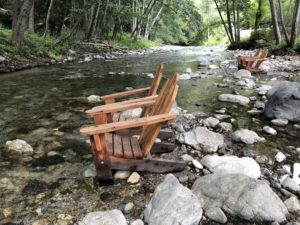-
Big Sur River Inn: Dip Your Toes in the River
The venerable Big Sur River Inn is perched on the banks of the Big Sur River. It began humbly in 1934, when Ellen Brown opened the inn and began serving hot apple pie to guests. Her famous apple pie, which is still on the menu today, gave the place its original name, “Apple Pie Inn”. Ellen was a descendant of the famous Pfeiffer family for whom a park and beach are named.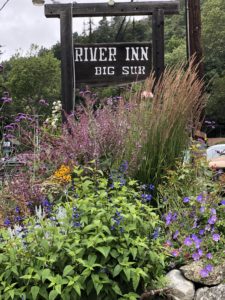
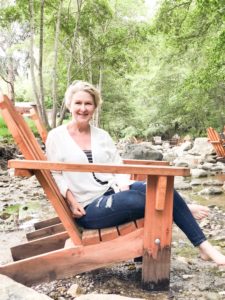 The Big Sur River Inn is now known for its famous Adirondack chairs in the river. Yes, IN the river. I must add that the river is so shallow, a chicken could wade across and get nary a feather wet. It is also well shaded and lined with gorgeous smooth river stones. You can take your glass of wine or bottle of beer and sit IN THE RIVER with your family and friends. You will love dipping your toes in the cool and crystal clear water. Could there be anything more idyllic on a hot day? Big Sur River Inn is located on the west side of Highway 1 and is surrounded by lush forestry and campgrounds. Its central location makes it an ideal place from which to explore Big Sur’s redwoods, hidden coves, and famous landmarks. It is less than 3 miles from Big Sur Station, Andrew Molera State Park, and Pfeiffer Big Sur State Park.
The Big Sur River Inn is now known for its famous Adirondack chairs in the river. Yes, IN the river. I must add that the river is so shallow, a chicken could wade across and get nary a feather wet. It is also well shaded and lined with gorgeous smooth river stones. You can take your glass of wine or bottle of beer and sit IN THE RIVER with your family and friends. You will love dipping your toes in the cool and crystal clear water. Could there be anything more idyllic on a hot day? Big Sur River Inn is located on the west side of Highway 1 and is surrounded by lush forestry and campgrounds. Its central location makes it an ideal place from which to explore Big Sur’s redwoods, hidden coves, and famous landmarks. It is less than 3 miles from Big Sur Station, Andrew Molera State Park, and Pfeiffer Big Sur State Park.
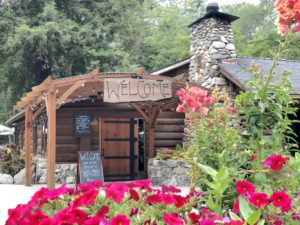 Since I am a local resident, I have never stayed at the Inn, but I have eaten at their restaurant and the food is amazingly delicious. They offer breakfast, lunch and dinner menus. You may choose to eat indoors in their rustic cabin-like dining room, on their lovely deck, or in those famous chairs in the river. Big Sur River Inn clearly take pride in their landscaping, so that in every direction you look you see a beautiful floral vista. There are also a myriad of wildlife here. During my most recent visit, I was serenaded by a group of gorgeous blue Steller’s Jays as they socialized on the river bank.
Since I am a local resident, I have never stayed at the Inn, but I have eaten at their restaurant and the food is amazingly delicious. They offer breakfast, lunch and dinner menus. You may choose to eat indoors in their rustic cabin-like dining room, on their lovely deck, or in those famous chairs in the river. Big Sur River Inn clearly take pride in their landscaping, so that in every direction you look you see a beautiful floral vista. There are also a myriad of wildlife here. During my most recent visit, I was serenaded by a group of gorgeous blue Steller’s Jays as they socialized on the river bank.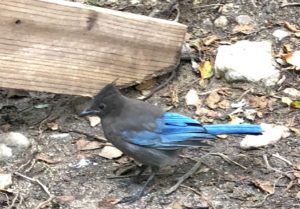 On Sunday afternoons, there is live music on the riverside deck. There is also a gas station (the only one for miles) and a small general store with food and camping supplies on the premises. For more information see River Inn. If you are searching for a down-to-earth, affordable, fun and relaxing place to visit, I would highly recommend the Big Sur River Inn!
On Sunday afternoons, there is live music on the riverside deck. There is also a gas station (the only one for miles) and a small general store with food and camping supplies on the premises. For more information see River Inn. If you are searching for a down-to-earth, affordable, fun and relaxing place to visit, I would highly recommend the Big Sur River Inn!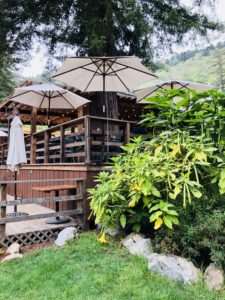 Thank you for visiting my blog! Wishing you peace, love, happiness, & beautiful vistas!
Thank you for visiting my blog! Wishing you peace, love, happiness, & beautiful vistas! -
Old Monterey Farmer’s Market on Alvarado Street
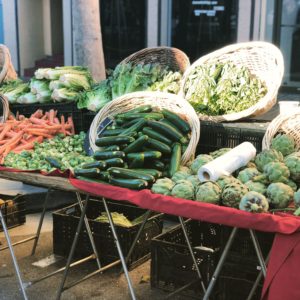
The sights, sounds and smells of the Old Monterey Farmer’s Market on Alvarado Street entice your senses the moment you get near. Vendors line the street selling fresh organic Medjool dates, turnips, carrots, broccoli, cauliflower, lettuce, artichokes, persimmons, lemons, grapefruit, apricots, almonds, raspberries & strawberries. Buckets of colorful flowers are scattered nearby. Street musicians play eclectic melodies on guitars, mandolins and violins as dogs lie dolefully next to them. Walk further along, and you will hear the crackling sound of Edith Piaf tinkling in the air. A man in a brown hat is playing very old records on an antique Victrola he has set up curbside.
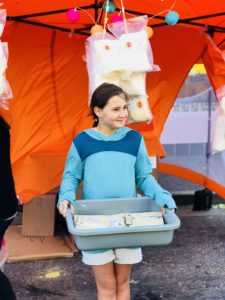

Life seems genuine and easy here, and you can slowly peruse everything pervading your senses. Two young girls are selling pineapple flavored cotton candy. There is a woman selling hats and another with hand-made jewelry. Next to her, a man hawks his organic eggs and glass jars of local honey. A grizzled fellow with exotic red and blue parrots and white cockatoos stands on the corner. Local bakeries have set up tables filled with pastries, baklava, donuts, cookies, cupcakes, churros, biscotti, pies, brownies, muffins and more. There is the smell of tamales, fried squid, and falafel melding in the air. In Monterey, variety is indeed the spice of life. You will find every cuisine here, including Indian, Mexican, Japanese, French, Cuban, Italian, Greek, Lebanese, Thai, & Korean, to name but a few.
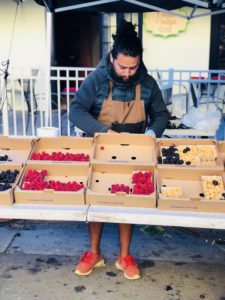
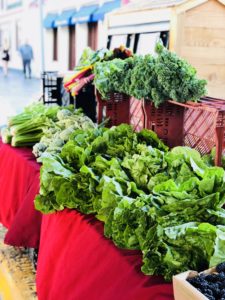
Cannery Row and Fisherman’s Wharf are great, but if you are visiting Monterey and really want the whole Monterey cultural experience, you really have to check out the Old Monterey Farmer’s Market. It is located on Alvarado Street between Del Monte and Pearl every Tuesday. Hours are October through April: 4:00-7:00 pm and May through September: 4:00-8:00 pm. You will NOT be disappointed! For more information, see oldmontereyfarmersmarket
-
A Single Ember: Soberanes & California Wildfires
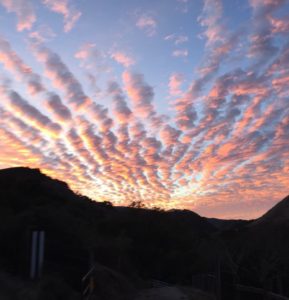
Living in California involves a delicate dance between nature and man. The high drought of summer contrasts with the lush rainy season of winter. One can become complacent, expect things to go on just as perfectly as ever in this coastal paradise, never realizing that one small spark can lead to such horrible consequences. California wildfires are becoming bigger and more devastating, and there cannot be too much education regarding prevention, in my opinion. There is a new ad campaign out with the message “A single ember can travel over a mile”, and I seriously hope people think about this.
The year I moved to my farm there was a fire in north Corral de Tierra, supposedly caused by a trailer dragging chains along the highway, which created a series of sparks jumping alongside the dead grass ditches and transmogrifying into a pitched wildfire. There was also another fire to the south in Tassajara set by a purportedly suicidal man who set himself on fire in his car, initiating a wildfire which burned uncontrollably for weeks. Last year I journaled my experience during the devastating 2016 Soberanes fire.
—I see a faint flicker of difference in the lighting the minute I step outside. The normally blue sky is now somewhat pink as if someone is holding a gargantuan piece of rose colored fabric between the sun and earth. I do not see flames but I soon learn their inauspicious cause. It is coming from Soberanes, an area located south of Monterey and Carmel, with trails snaking through steep hills overlooking the Pacific Ocean along the Big Sur Coastline. Local firefighters as well as those from further north in San Francisco are now battling the fire in this remote and heavily forested area.
Each day I wake to find a smattering of white flakes like a delicate sprinkling of fine snow powdering the tawny hillside. It is ash confetti from the wildfire being blown over in a sobering morning kiss. I see photos of firefighters on the news contrasted with smoke and flame. Their faces are cavernous and hollow. Their eyes are worn, haunted. They look tired of the fighting the flames. They just look done in. By day 10, the fire is approaching Carmel Valley. They say five fire lines have been cut to prevent the fire from reaching the village. That is what they say.
It has now been over two weeks and the fire is moving south. They say it is 50% contained. The firefighters say it was caused by an illegal campfire set at the junction where two meandering creeks met to form a waterfall in the depths of Garapatta forest. At least 57 homes and buildings have been burned up, and a bulldozer operator working to clear brush was killed when his bulldozer topped over on the steep terrain, crushing him beneath. The horrible stench of smoke I have awoken to the past several days is waning, although they say on the news our poor air quality is approaching that of Delhi, India.
Who set the campfire? Stories have been circulating. One involves a group of homeless people from Santa Cruz who were asked to leave by forest rangers but returned later to move even further into the forest. Was it a campfire of revenge? Another story involves the possibility of a couple out for a hike who became enticed by the beauty of the streams and waterfall and stopped for a romantic tryst, hastily lit a campfire, then abandoned it. Stories are stories. Whatever the reason, the effect of their actions is entirely devastating.—
The Soberanes Fire was eventually quelled after three months, and was deemed the most expensive wildfire to fight in United States history. Sadly, most wildfires are caused by PEOPLE. According to CalFire and the Forest Service, the following can cause wildfires: burning debris, smoking, unattended campfires, kids playing with matches, sparks from trains, outdoor equipment such as weed whackers, and the heat from catalytic converters in autos. If you are visiting California, please check with the local authorities before having a campfire. There are often strict penalties for unapproved fires here, and as you can see, for good reason. Peace out!
-
Butterfly Town: Pacific Grove
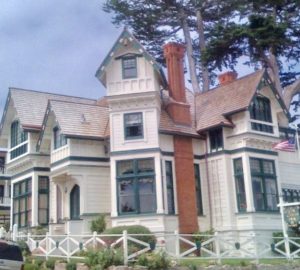
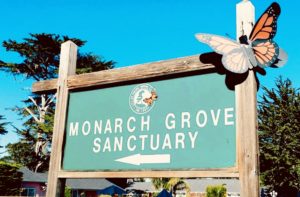
What do butterflies and quaint seaside Victorian houses have in common? Pacific Grove! Called “PG” by the locals, it is a quiet town filled with history and charm. It was originally a Methodist Church camp in the late 1800s and nowadays boasts more historical houses per capita than anywhere in California. Perhaps owing to its pious history, it was the last dry town in California and did not serve liquor until 1969! It is also known as Butterfly Town, due to the thousands of monarch butterflies that overwinter here on the Monterey pines and eucalyptus trees. You can see them at the Monarch Grove Sanctuary beginning in October through March, when they take flight to migrate as far away as Canada, laying their eggs on milkweed plants along the way. Every October, the town of PG holds a Butterfly Parade to celebrate the return of the monarchs, and the school children don colorful butterfly wings and march through the town. These gorgeous creatures are becoming endangered due to deforestation and development, and PG takes this very seriously. If you kill or threaten a butterfly in PG, you can get slapped with a $1000.00 fine. You can help support the butterfly population by planting milkweed! I did last year and hope to spot some of our orange & black friends at my farm.
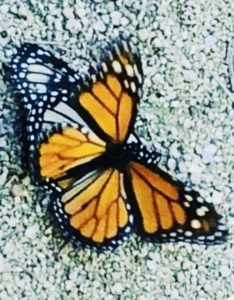
Pacific Grove is also home to the famed “Lover’s Point”, where Asilomar State Beach begins. Asilomar means “asylum or refuge by the sea”, and it fits this description perfectly. If you are looking for the best place to watch the sunset, this is it! It is pure heaven to wander along the wonderful walking/running trail lined with exotic shrubs and flowers next to the rocky coast and crashing waves and is one of my favorite places to take my dog for a walk. You can stop to examine the tide pools or watch the sailboats along the way.
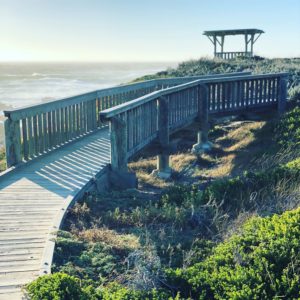
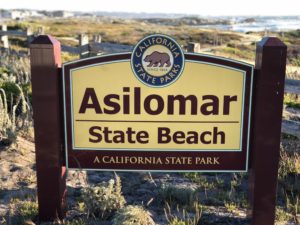
The Asilomar Conference Center, part of the Asilomar State Beach, was designed by Julia Morgan. Morgan is also famously known for being the architect of Hearst Castle, which lies much further down the coast. Asilomar was originally built in the early 1900s for the YWCA, and still retains a very lodge-like Arts and Crafts/Mission look, with wonderful shingled and stone buildings, cozy fireplaces and gorgeous lighting. Did you know that the first national discussion regarding recombinant DNA was held at Asilomar? Do you care? Just thought I’d throw that in there.
In July, PG hosts the Feast of Lanterns, a Chinese festival that lasts for a week and you will see lanterns hanging all over town at this time. In December, you can walk down “Candy Cane Lane”, and see all the festive lights and decorations for the holidays. There is also a tour of the amazing inns and bed and breakfasts at this time of year. My favorite is the Green Gables Inn, but really, they are all pretty amazing. There is always, ALWAYs something fun going on in PG!
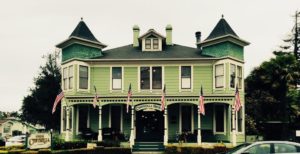
-
Big Little Lies: Celeste’s Apartment in Monterey

For those of you as obsessed with Big Little Lies as I am, the fact that they are filming a second season is quite exciting. For those of you not familiar with this HBO miniseries, here is a synopsis:
The Cathartic Finale of “Big Little Lies”
As the series progresses, the structural gimmick begins to make the murder feel extraneous, almost as though it were a red herring—and the most delicious thing about the finale is that, in a way, we learn, it is. The great revelation of “Big Little Lies” is not the identity of the murder victim (it’s Perry, Celeste’s abusive husband, luridly played by Alexander Skarsgård), or the identity of the killer (that would be Bonnie, the young bohemian married to Madeline’s ex-husband, and played by Zoë Kravitz; she sees Perry beating Celeste and pushes him over a drop-off—in the book, Bonnie has her own history of being abused). The finale was set up to answer a different question. The women have been revealing their secrets in pieces throughout the series, and Jane’s secret is that her son, Ziggy, was conceived in a violent rape by a man she had just met. When, on the night of the fund-raiser, Perry approaches Celeste in a predatory fever, Jane, who has not previously been introduced to Celeste’s husband, suddenly recognizes his look: Perry is the man who picked her up, gave her a fake name, and assaulted her in a motel room. He has raped both of them, and fathered their sons.
Part of what has made “Big Little Lies” stand out amid the ever-growing crowd of interesting TV shows is its utterly natural rendering of violence as an ordinary part of women’s lives. (My colleague Emily Nussbaum described the show in her review as “a reflection on trauma.”) The show understands that minor social transactions between women can express the nuances of violence with a unique specificity and a nauseating subtlety. Jean Marc-Vallée, the director, roams these sun-drenched, luscious settings with a handheld camera and a sense of unease. In the finale, just before the climax, as a ballad drifts in from the lantern-lit party, fifteen remarkable seconds pass. One of Jane’s P.T.S.D. flashbacks has merged with the present, confirming Perry’s identity; her face becomes a mask of fear. Madeline looks at her, follows her gaze to Perry, and then looks back at Jane, altered—she’s figured it out. Madeline catches Celeste’s eye and turns it toward Jane, who nods almost imperceptibly. The show’s twist has been communicated wordlessly among all three of them. Witnessing this, Perry panics, and lunges forward to bludgeon his wife.
It’s an electric sequence. Witherspoon, as Madeline, was the immediate draw of “Big Little Lies,” with her mutinous Tracy Flick charm resurrected and blazing. But Kidman, as Celeste, emerged as the real showstopper. She has the most ambitious narrative arc in the series, the widest gap between appearance and truth. To friends and neighbors, her relationship with Perry looks dreamy and lustful; it’s actually a maelstrom of codependency and marital rape. (Male critics have written differently about “Big Little Lies” than women, by and large—at the Times, Mike Hale noted that Celeste was an abuse victim but then compared her relationship with Perry to “Fifty Shades of Grey.”) Celeste responds to abuse in a manner that feels painfully realistic. She tries to take ownership of her situation by hitting him back; she tries to find pleasure in it, fitting her lust around his blows. She articulates a neat narrative to Madeline; then a messier one to a therapist (Robin Weigert), with Perry present; then she tells an increasingly honest story as she returns to the therapist alone. By the final episode, Celeste has rented and furnished an apartment; a brutal and unambiguous beating has made her ready to leave with her twin sons. But Perry sees a message from the property manager on Celeste’s phone just before they leave for the fund-raiser, and, watching husband and wife get in their car, leaving the kids behind with a babysitter, you fear for her life.
By then, the show’s secondary mystery has been solved. There’s a bad seed in Otter Bay’s first-grade classroom: some kid has been bullying a girl named Amabella, who, in the first episode, identifies Jane’s son Ziggy as her attacker. Ziggy, though, maintains his innocence, and, in the finale, he reluctantly tells Jane that the kid who has been choking and biting Amabella is Max—one of Celeste’s twins. On the day of the fund-raiser, Jane breaks the news to Celeste as gently as she can. “I definitely considered the fact that he could be lying just to protect himself,” Jane says, referring to Ziggy. “And I had to face the fact that violence could be in his DNA, given who his dad is.” Celeste reels. She’s been telling herself that the twins don’t know about the abuse, but we know this is wishful thinking: the finale opens with a shot of an air vent in Celeste’s basement, through which the boys, playing with video games and toy guns, can hear her scream. Their world is already a miniature version of Celeste’s, beautiful and violent. “They grow out of it,” Jane says to Celeste about bullying kids. “Sometimes they don’t,” Celeste replies.’
As you may know, the film is centered in Monterey. Parts of it have been filmed here, including scenes at Fisherman’s Wharf, Bixby Creek Bridge, Monterey Bay Aquarium, Garrapata State Park, Lover’s Point, Monterey City Hall, and Delmonte Beach.
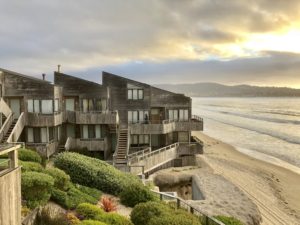
The beach complex here was the site of Celeste’s (Nicole Kidman) apartment when she finalized her plans to leave her abusive husband. Filming started here again this year with Meryl Streep playing her mother-in-law and Nicole posted this photo on her Instagram in April:

I think that Celeste’s choice of an apartment on Delmonte Beach represents a continuation of the theme seen throughout the series. That theme is her connection to the ocean and how it is either a source of joy and contentment, or frightful and dangerous. As someone who has personally experienced violence and abuse, I feel a very real connection to Celeste’s character. I want her to escape, and be safe, just as I did.

I can’t wait to see the new season of Big Little Lies and see how all the scenes filmed here play out in the whole drama. Thank you for visiting my blog! Wishing you peace, love, happiness and beautiful vistas!
-
Point Sur Lighthouse in Big Sur, California
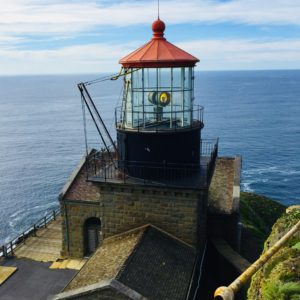 Located between Carmel and Big Sur, the 48-foot high sandstone Point Sur lighthouse stands duty, warning ships approaching the treacherous coast. Point Sur, a National Historic Landmark, is the only complete turn-of-the-century light station open to the public in California. The lighthouse was originally fueled by whale oil, lard oil, and kerosene before becoming electric in 1948. It used a Fresnel lens invented by Augustin Jean Fresnel, a French physicist, until the 1970s. It is still in use today, operated by the U.S. Coast Guard.
Located between Carmel and Big Sur, the 48-foot high sandstone Point Sur lighthouse stands duty, warning ships approaching the treacherous coast. Point Sur, a National Historic Landmark, is the only complete turn-of-the-century light station open to the public in California. The lighthouse was originally fueled by whale oil, lard oil, and kerosene before becoming electric in 1948. It used a Fresnel lens invented by Augustin Jean Fresnel, a French physicist, until the 1970s. It is still in use today, operated by the U.S. Coast Guard. 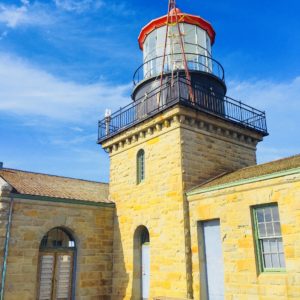
During its history, Point Sur has been home to four lightkeepers and their families. Beginning in 1899 up until 1974, these lighthouse keepers and their families lived in isolation in this remote and desolate place. Supplies were brought every four months by ship. It is hard to imagine what life must have been like for these folks, without the modern conveniences that we take for granted and so distant from the rest of the world. To live at Point Sur clearly required grit. Point Sur could originally be reached only by boat, as it was an island. Now, it is reached by walking a little less than a mile from the parking lot below.
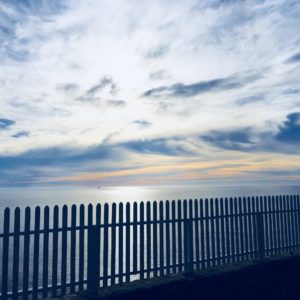 Despite a light that could be seen for 23 nautical miles and a coal-powered fog horn, the Point Sur lighthouse still witnessed its share of shipwrecks. If you are interested in ghosts and haunted places, you may enjoy the Ghost Hunts and annual Halloween Tours. Nature lovers may also enjoy the Whale Watch Tours. Gray whales are often seen on their migration route during the winter and during the summer you may see humpback and blue whales.
Despite a light that could be seen for 23 nautical miles and a coal-powered fog horn, the Point Sur lighthouse still witnessed its share of shipwrecks. If you are interested in ghosts and haunted places, you may enjoy the Ghost Hunts and annual Halloween Tours. Nature lovers may also enjoy the Whale Watch Tours. Gray whales are often seen on their migration route during the winter and during the summer you may see humpback and blue whales. 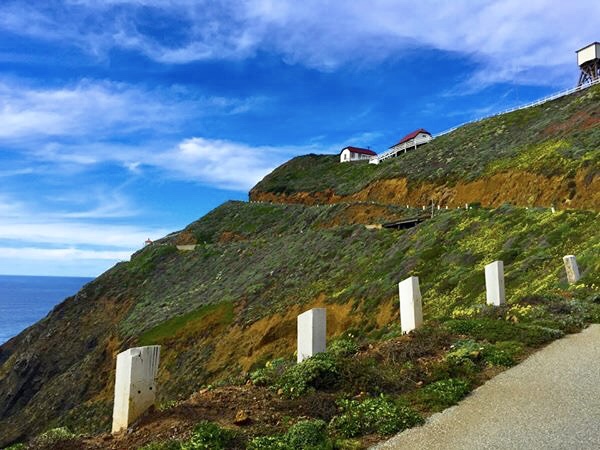 Tours last approximately three hours and are led by docents. It can be very cold and blustery so bring a jacket or sweater to be on the safe side. You will also have to do a great deal of walking, so sensible footwear is advised. You have to climb almost a mile with a 360-foot elevation to get to the lighthouse. There is a picnic area surrounded by a cute picket fence so bring a lunch and enjoy the amazing views! If you are planning on visiting the lighthouse and have questions regarding parking, fees, and tour schedules, call 831-625-4419 or see Point Sur Lighthouse
Tours last approximately three hours and are led by docents. It can be very cold and blustery so bring a jacket or sweater to be on the safe side. You will also have to do a great deal of walking, so sensible footwear is advised. You have to climb almost a mile with a 360-foot elevation to get to the lighthouse. There is a picnic area surrounded by a cute picket fence so bring a lunch and enjoy the amazing views! If you are planning on visiting the lighthouse and have questions regarding parking, fees, and tour schedules, call 831-625-4419 or see Point Sur Lighthouse- September through March Tours are Saturday and Sunday at 10:00 am and Wednesday at 1:00 pm
- April through August Tours are Saturdays and Wednesdays at 10:00 am and 2:00 pm, Sundays 10:00 am, and only in July and August, Thursdays at 10:00 am
- For regular tours, adults are $15, ages 6-17 are $5, and children 5 and under are free
- Moonlight Tours in 2018 are Sunday, August 26 and Monday August 27 at 6:45 pm, and Monday, September 24 and Tuesday, September 25 at 6:00 pm
- For Moonlight tours, adults are $20, ages 6-17 are $10, and ages 5 and under are free
- Arrive early; first come, first served (reservations are not accepted)
- Visa, Mastercard, American Express and Discover are accepted
- No visitors may remain in their vehicles
- No pets ( even left in cars), large motorhomes or campers, baby strollers, or smoking is allowed
Thank you for visiting my blog! Wishing you peace, love, happiness & beautiful vistas!
-
The Art of the Artichoke
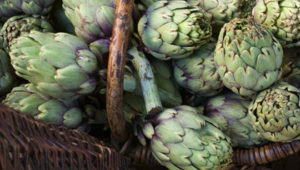
If you are from the midwest, chances are, like me, the closest you have been to an artichoke is eating the spinach artichoke dip at your nephew’s graduation party. In the Monterey area, however, artichokes are big, so big that they have an annual artichoke festival. It is actually an artichoke and WINE festival, because hey, what is a festival without wine? If you are in the Monterey area this weekend you should check it out! it is being held at the Monterey County Fair & Event Center. I went last year and the highlights for me were eating the fried artichoke hearts (super yum!) and listening to chefs from local restaurants discuss the proper way to cook fresh artichokes. To me, this was important, because the first time I tried cooking them it was a disaster. I learned that you do not boil them, you STEAM them. Eating them was also a novel experience. Here’s how: you take a leaf from the cooked artichoke, put the base of the artichoke leaf in your mouth, put your bottom and top teeth together, and slowly pull the leaf out, skimming the savory artichoke goodness off the leaf. The artichoke is actually the official state vegetable of California, and did you know? Nearly two-thirds of America’s artichokes are grown in Castroville, a small town located north of Monterey. Another interesting fact: Marilyn Monroe served as honorary queen of the Artichoke Festival in 1948 before she became famous.
One of my favorite ways to eat artichokes is in Lemon Chicken Artichoke Soup. My friend Anushka (yes, I named my goat after her) actually told me about this delicious recipe and I adapted it. If you need a light and nourishing soup to warm your spirits this is it!
Monterey Farmgirl’s Lemon Chicken Artichoke Soup
1 lb. skinless chicken breasts, cut into 1-inch pieces
3 leeks, sliced
2 tbsp olive oil
3 cloves garlic, minced
1 bay leaf
(1) 14 oz. can artichoke hearts, drained
4 cups chicken stock
1 cup kale leaves, torn
Juice of 1 lemon
1-2 tsp. thyme, chopped
Pepper to taste
Instructions:
- In a large pot, sautee the leeks in the olive oil for about 5 minutes, or until they are tender and start to turn golden.
- Add the chicken, garlic, bay leaf, artichoke hearts, chicken stock, kale, and thyme and bring to a simmer, cooking for 30 minutes.
- Add the lemon juice and pepper
